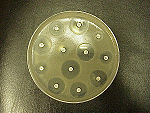
Antibiotic sensitivity
Encyclopedia

Bacteria
Bacteria are a large domain of prokaryotic microorganisms. Typically a few micrometres in length, bacteria have a wide range of shapes, ranging from spheres to rods and spirals...
to antibiotic
Antibiotic
An antibacterial is a compound or substance that kills or slows down the growth of bacteria.The term is often used synonymously with the term antibiotic; today, however, with increased knowledge of the causative agents of various infectious diseases, antibiotic has come to denote a broader range of...
s. Antibiotic susceptibility testing (AST) is usually carried out to determine which antibiotic will be most successful in treating a bacterial infection in vivo. Testing for antibiotic sensitivity is often done by the Kirby-Bauer method
Kirby-Bauer antibiotic testing
Kirby-Bauer antibiotic testing is a test which uses antibiotic-impregnated wafers to test whether particular bacteria are susceptible to specific antibiotics. A known quantity of bacteria are grown on agar plates in the presence of thin wafers containing relevant antibiotics...
. Small wafers containing antibiotics are placed onto a plate upon which bacteria are growing. If the bacteria are sensitive to the antibiotic, a clear ring, or zone of inhibition, is seen around the wafer indicating poor growth. Other methods to test antimicrobial susceptibility include the Stokes method, E-test (also based on antibiotic diffusion). Agar and Broth dilution methods for Minimum Inhibitory Concentration
Minimum inhibitory concentration
In microbiology, minimum inhibitory concentration is the lowest concentration of an antimicrobial that will inhibit the visible growth of a microorganism after overnight incubation. Minimum inhibitory concentrations are important in diagnostic laboratories to confirm resistance of microorganisms...
determination.
Ideal antibiotic therapy is based on determination of the aetiological agent and its relevant antibiotic sensitivity. Empiric treatment is often started before laboratory microbiological reports are available when treatment should not be delayed due to the seriousness of the disease. The effectiveness of individual antibiotics varies with the location of the infection, the ability of the antibiotic to reach the site of infection, and the ability of the bacteria to resist or inactivate the antibiotic. Some antibiotics actually kill the bacteria (bactericidal), whereas others merely prevent the bacteria from multiplying (bacteriostatic) so that the host's immune system can overcome them. Muller Hinton agar is most frequently used in this antibiotic susceptibility test.
For example, gram (+) bacteria are sensitive to penicillin.
See also
- AntibioticAntibioticAn antibacterial is a compound or substance that kills or slows down the growth of bacteria.The term is often used synonymously with the term antibiotic; today, however, with increased knowledge of the causative agents of various infectious diseases, antibiotic has come to denote a broader range of...
- Antibiotic resistanceAntibiotic resistanceAntibiotic resistance is a type of drug resistance where a microorganism is able to survive exposure to an antibiotic. While a spontaneous or induced genetic mutation in bacteria may confer resistance to antimicrobial drugs, genes that confer resistance can be transferred between bacteria in a...
- Miles-Misra methodMiles and Misra methodThe Miles and Misra Method is a technique used in Microbiology to determine the number of colony forming units in a bacterial suspension or homogenate....

